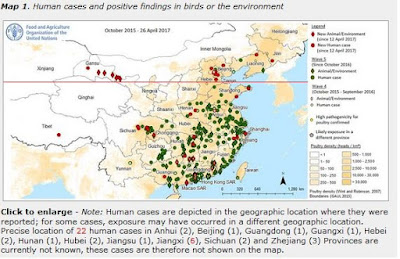 |
| FAO Apr 26th - Modified With North/South Line |
#12,412
During its first four years of circulation, H7N9 has been largely a central and southern Chinese problem. Reports of human infections, or detections in birds or the environment, above the 38th parallel have been rare.
As of the start of this 5th wave (October 2016), Beijing had only reported 9 cases since the virus emerged in 2013, while Jilin and Liaoning Province had each only reported 1. Gansu Province, in the northwest of the country, had never detected the virus at all.As of the latest HK CHP report (Apr 24th), Beijing had jumped to 22 cases, Liaoning to 4, Jilin to 3, and Gansu had reported 2 cases. These regions have also reported increased bird and environmental detection. Most of these `northern' cases have come in the past month.
While these numbers still pale compared to the 138 cases reported this year in Jiangsu, the 87 from Zhejiang, or the 63 reported by Guangdong, the late season encroachment of H7N9 into the capital city and surrounding northern provinces has started to raise concerns.
Apart from the public health implications, the entrenchment of the virus in Beijing - just months before their 19th National Congress of the Communist Party of China - could cause some serious political ramifications this fall.This recent surge in northern cases, combined with a drop off in reports from the south (noticeably Guangdong province, which hasn't reported a new case in a month), has led to some speculation in the Chinese media that the virus is starting to spread better in the north, than in the south.
While understandably disconcerting to the millions of northern Chinese who have - until recently - felt relatively separated from these yearly H7N9 epidemics, the numbers this year don't support that assertion.But speculation in China has apparently grown to the point that their CDC felt compelled to address the issue, and overnight a number of Chinese media outlets are carrying versions of the following (translated) story.
Northern areas are more susceptible to H7N9 bird flu? CDC denies the existence of this trend
2017-04-26 19:16:05
Beijing News News (Reporter Wu) April 26, for the "northern region of human infection with H7N9 influenza cases increased significantly," the media release and reprint of "bird flu this year, the North is more susceptible than the south" and other phrases, Chinese Center for Disease Control and Prevention virus disease control and prevention deputy director, director of the national influenza Center Shu Yuelong to Beijing News reporter said there was no evidence that the northern regions are more susceptible to H7N9 avian influenza.
Some media reports said, "The recent human infection with H7N9 influenza northern region of cases showed an increasing trend, April 24, according to incomplete statistics, in April, Shandong, Hebei, Liaoning, Beijing and other regions reported a total of 17 cases of human infection with the H7N9 flu."
Beijing News reporter combing found that according to public information, since this month, there are indeed more northern Shandong, Henan, Hebei, Liaoning, Jilin, Beijing and other provinces reporting cases of human infection with H7N9. April, Shandong report four cases; Henan, Hebei new cases were reported two cases and four cases; confirmed in Liaoning April 20 Nisshin one case; and Jilin also on April 22 this year the first case was found.
However, public data also show that since 2017, Guangdong, Guangxi, Jiangxi, Zhejiang, Jiangsu, Hunan, Gansu and Anhui and other areas also appear more cases of human infection with the H7N9 flu. According to the National Health and Family Planning Commission recently informed, in 2017, China's mainland has 22 provinces reported cases, 511 cases of H7N9, which killed 188 people.
In this regard, Shu Yuelong, said Nationwide, this year there is no evidence that the northern people more susceptible to H7N9 influenza. "The recent increase in the northern region, due to the wider spread of the virus, reported cases in northern and southern regions has increased." Shu Yuelong said there was no detection of cases of human infection with H7N9 flu a "South", "North" so obvious the regional differences.
Since we've seen some significant genetic changes in the H7N9 virus (more accurately, viruses) this year - along with some subtle changes in behavior - it is impossible to say what this summer and next fall have in store.
There have been concerns raised that the virus is becoming more `heat tolerant', which may increase its presence during the summer months. And the impact of an HPAI version of the virus, reported last January in Guangdong Province, remains to be seen.As we've seen with H5N1, H5N8, and H5N6, avian flu viruses in China have a habit of eventually expanding their geographic range. While northern China may be at greater risk of seeing cases than in the past, the bigger concern is what happens if, and when, H7N9 hitches a ride on migratory birds into Russia, North Korea, Japan, India, Vietnam, or Laos.